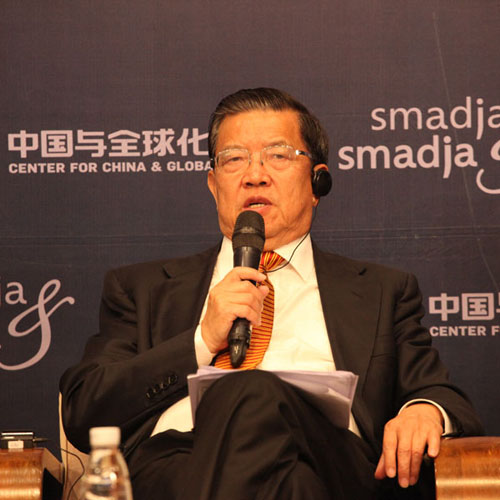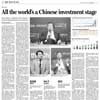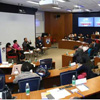-
沈南鹏:中国制造在新产业中容易弯道超车
从蒸汽到电气到互联网时代,人类已经经历了三次工业革命。而在现在这样一场全球制造业回归的浪潮之下,我们正在经历第四次工业革命。在这次工业革命当中,中国制造如何参与其中?中国制造的未来在哪里?而在“中国制造2025”的背景下,中国又应该站在全球制造业价值链的哪个位置? 本次达沃斯论坛上,CCTV主持人李斯璇与红杉资本全球执行合伙人沈南鹏、清控公司董事长徐井宏、经济学教授林毅夫、斯坦福教授 Amy Wilkinson 和俄铝董事长 Oleg V. Deripaska 一道就「中国制造的未来」展开的圆桌讨论。讨论中,沈南鹏指出,中国制造在新产业中容易弯道超车。 在先进制造、传统制造业升级改造、智能硬件等领域,红杉资本中国基金这十年来始终是重要参与者。红杉中国对此有着深入的行业研究和投资见地:在传统制造业领域,投资的乾照光电于 2010 年在创业板上市 ,首航节能于 2012 年在中小企业板上市;智能硬件企业也不断在国际舞台突破创新,如大疆创新占据全球无人机市场 70% 以上的比重,Ninebot于今年四月完成对电动平衡车鼻Segway的全资收购。这个领域,我们投资的企业还包括:首航节能、乾照光电、中曼石油天然气集团、国能中电、国开新能源、蔚来汽车、大疆创新、小米手环、The ONE智能钢琴、Ninebot、出门问问智能手表、Makeblock等等。 关于本次圆桌讨论已经在1月31日央视2套的「环球财经连线」栏目中播出,想要了解详情的小伙伴们不要错过。今天先来一起回顾一下讨论中的观点精选:观点精选 您认为中国制造的人才会从哪里来? 沈南鹏:从创业资本到法律法规,再到允许失败的创业文化,美国拥有的一套成熟创新生态体系,如今中国都已具备。不同的是,在美国,大量的人才是来自世界各地的,而在中国,创新创业成功的主要力量还是来自于本土,当然其中很多是海外留学回来的优秀人才,他们在创业当中也扮演了非常重要的角色。未来我们更多要做的可能是吸引全世界的人才到中国创业。 您怎么看待公司并购问题?IP是想买就能买得到的么?另外并购来的人才怎样才能留得住? 沈南鹏:在并购过程中存在两个问题:1. 是否有能力去购买世界上最好的知识产权,2. 购买之后是否能够整合。 并购过程中,企业拥有者可能更看重出售的金额,而管理层则可能更看重未来的合作伙伴。以以色列为例:过去三十年中以色列有大量的公司卖给了美国,原因很简单,美国有巨大的国内市场并且有大量资本;以色列有人才,但是国内市场有限。我认为中国现在处在一个非常好的位置上:中国有资本,还有很好的市场,这些对于具有创业精神的管理团队而言有巨大的吸引力。而我们还需要做到的是要有一定的人才储备,才能在并购完成之后更好地进行管理和整合。 “中国制造2025”或者说第四次工业革命究竟需要一些什么样的人才? 沈南鹏:我们在优秀创业者身上看到一个重要特征——好奇心,好奇心可能是他们在追求整个技术发明的过程中的重要驱动力量。 另外,优秀的科技创新型企业的领军人物往往是复合型人才,或者叫跨界人才。他们既有非常强的科技研发能力和背景,同时又具有对企业管理和市场的敏感度,只有将这两种特质很好结合的领导人,才能真正领导创新型企业。 如何重塑“中国制造”这个品牌? 沈南鹏:品牌的塑造需要时间的积累,我们现在无法苛求在世界100个知名品牌中中国企业所占的比例。但是我持乐观态度,因为互联网时代给中国品牌提供了机遇。全世界已经铺设好一条信息高速公路,电子商务建立起了全球网络,这些品牌可以通过电子商务平台快速建立自己的口碑。 如果要打造一个具有国际竞争力的企业,它的企业领袖应该有什么样的企业家精神?请用一句话讲一下。 沈南鹏:企业家既能深谙中国文化,又拥有广阔的国际视野。 文章选自红杉汇,2016年2月1日
2016年2月4日 -

【中国日报】世界皆是中国的投资舞台
原国家外经贸部副部长龙永图认为中国企业走向世界趋势不可逆转。图片来源:陈颖群/中国日报 中国日报2月1日电 (记者 陈颖群)中国最重要的节日——农历新年在即,但舒文斌并没有休息的打算,也没有时间参加聚会。相反,这是他一年中最忙的时候。 除了要跟国内潜在合作伙伴开会之外,这位五洲环球装饰工程设计公司的总经理也在计划着去美国及其他市场出差,寻找节后可能捕捉的商机。 “过去两年,中国房地产及建筑业发展减缓,新建住宅及商业项目呈现疲软之态,投资前景尚不明朗。”舒文斌说。 “像东南亚及南美等地的海外市场将成为新起之秀。欧美市场前景也十分乐观。” 舒文斌的公司主营室内设计及装修。2012年,在其合作伙伴,某大型国企的帮助下,该公司开始了其海外业务。目前,这一公司里有150名员工,年收入为三亿元,其中20%来自海外。 以往该公司每年约有30%的增长率。但过去两年里,建筑业发展减缓,劳动力及原材料价格上升,在全球范围内寻找新的商机成为诱人的选择。王辉耀,中国与全球化智库(CCG)主任 “我们打算在国外设立公司并直接运营,并且我希望到2017年底,公司一半的收入都来自海外。”舒文斌说道。 舒文斌的公司是典型的中国中小型企业。目前中国政府正加快经济体制改革,并减轻海外投资的限制。这一形式下,这些企业纷纷向全球发展。 中国企业备受关注的西方并购活动像是一场强行闯入行为,但据商务部数据显示,直到2014年,中国境外投资才达到1400亿人民币,首次超过境内投资(1200亿人民币)。同年习近平主席预测,此后十年间,中国境外投资将达到1.25万亿。 这一趋势还将加速。中国与全球化智库(CCG)出版的《中国企业全球化报告(2015)》指出,2014及2015年上半年,年均新增境外投资数为686,是2008到2013年(121)的六倍。吴建民,前中国驻法大使 前中国驻法大使吴建民表示,“我们正处于中国企业全球化大潮的风口浪尖。” “过去,只有许多大型公司才有兴趣进行全球化,但现在中小型企业也有意于此。许多公司已经意识到,如果他们不在全球内寻找商机,他们很可能最终在国内破产。” 据商务部统计,2015年,中国公司非金融类直接投资总额达1180亿美元,遍布153个国家的5085个公司,年同比增长14.7%。 王辉耀表示,约有63%的中国公司海外投资额在1亿美元到10亿美元之间。 王辉耀说:“小额境外投资(小于1亿美元)增长最快,私营公司及中小型企业占比增多。”他还表示,2014年,私营公司境外投资年同比增长295%,占总数的69%。 中国中小企业研究院院长肖强表示,大多数在研究院帮助下“走出去”的中小企业年营业收入在5000万至4亿元间,员工人数不超过2000。 他表示,研究院80%的对外投资案例来自中小企业,占到总投资额的30%。 原国家外经贸部副部长龙永图说,中国企业走向全球的趋势不可逆转。中国的企业和私人银行存款已经超过138万亿元,大量的剩余资本使中国企业能够更加便利地进行海外投资。 “全球化就是要在全球范围内进行资源分配。如果中国经济调整能够在全球背景下进行,那么经济转型就不会那么费力,也更加容易成功。”他说道。汪潮涌,信中利资本集团董事长 中国信中利投资集团是一家从事风险投资的机构,其创立者兼现任总裁汪潮涌提到,中国企业“走出去”主要有三种途径:产品,工业产能和资本。 “我见证了中国这三方面发生的巨大变化,”他说。“我看到产品质量有所提高,有了附加值,品牌质量也大有改善。工业产能的一大特色在于,无论是国有公司还是中小企业,它们抱团合作,共同开拓海外市场。” 至于资本全球化,过去,中国投资者通常选择购买美国国债,欧洲政府债券或是一些蓝筹股。但是现在,私募股权和风险投资已经成为资本“走出去”的主要收益来源。 “海外并购也在迅速增加。通过这种方式,很多公司能够获得海外产品、技术、销售渠道和设计等等,”他说。 深圳歌力思(Ellassay)服饰股份有限公司就是一个很好的例子。歌力思专注女性高级时装,最近以1118万欧元(约7950万元)收购了一家拥有德国时尚品牌Laurèl的香港公司以拓展国际市场。经过此次收购,歌力思将获得Laurèl在中国大陆门店的设计、定价和生产权。 全球投资贸易数据提供商迪罗基(Dealogic)公司最近的一份报告显示,中国跨境并购已经实现连续六年增长并于2015年首次突破1000亿美元关口,创下破纪录的1119亿美元。 波士顿咨询公司最近的一份报告表明了中国海外并购的变化趋势。1990年至2014年间,约40%的并购来自能源与资源领域。但是近些年来,只有20%的并购涉足能源与资源,而技术、品牌和市场份额约占并购的75%。 制造业十分重要。中国企业家们受政府为升级制造业而提出的“中国制造2025”国策的鼓舞,对制造业极为关注。 商务部的数据显示,2015年1月至11月,中国制造业的对外投资大约为118亿美元,年同比增长95.4%,其中设备制造投资高达58.9亿美元,年同比增长117.3%。文章选自中国日报,2016年2月2日
2016年2月4日 -
毛大庆:认识一座城从跑步开始
毛大庆,UR WORK 创始人、董事长,亿润投资高级合伙人,万科集团外部合伙人,中国与全球化智库(CCG)常务理事。 由马孔多文化主办的2016科勒杯北京野鸭湖冰雪马拉松昨日进行,这场号称“中国规模最大的冰雪马拉松”吸引了2022人参加,包括许多知名人士参与,比如优客工场创始人毛大庆,再比如奥运冠军邢傲伟、王丽萍。在跑者群体中,毛大庆用跑步治愈抑郁症的故事口口相传。从第一次跑马拉松到现在,他已经完成了31个全马、14个半马,并且完成了世界马拉松6大满贯。参加本次比赛前,毛大庆接受了新京报记者的采访。毛大庆表示,跑步是他的信仰。我的旅行箱里都会有一双跑鞋。想要认识一座城市,没有比穿上跑鞋去它的街道上跑步更合适的方式了。跑步缘三年半前因抑郁症开跑 新京报:第一次跑步是什么时候? 毛大庆:2012年伦敦奥运会开幕那一天,在奥森第一次跑步,开始了我人生第一个3000米。 新京报:当时因为什么开始跑步? 毛大庆:2012年上半年,整个人的生活状态非常糟糕,不好的生活习惯让自己陷入了恶性循环。加上市场不好、压力、酗酒等很多原因,生活节奏出现了紊乱。晚上睡不着觉,继而精力不足,食欲不振,一系列的身体和生理机能问题接踵而至,医生说,我得了抑郁症。后来意识到这样下去不行了,就在朋友的鼓励下开始跑步。 新京报:跑步给生活和工作带来了什么改变? 毛大庆:积极的心态,坚持不懈的勇气,不以物喜、不以己悲,活出了不一样的自己。没有马拉松,我也不会选择创业。创业同样是一场没有终点的马拉松,很累、很孤独,即便做足充分的准备还是会遇到种种艰难,筋疲力尽,甚至想要放弃。但世界上那么多种生活方式,既然选择了创业,就看谁耐得住了。创业就是在体力、心力、意志力的共同作用下,坚信只有向前这一条生路。现在,跑步已经变成了我的信仰。 新京报:现在跑步的频率怎样? 毛大庆:因为工作的关系,我平时跑步的时间不多。基本上以赛代练,周末的时候,会去参加一些马拉松比赛。 新京报:跑步的时候,你会想些什么? 毛大庆:很多人都问我这个问题,仔细想想,好像什么都没想。确实什么都没想,就是关注呼吸、节奏。跑马拉松都有一段最舒服的时候,就像一头鹿在奔跑,周围的风景都不重要,你才是主角,一种非常美妙的享受。跑步情首马难忘跑友全程助跑 新京报:3年多了,还记得第一次跑马拉松的感觉吗? 毛大庆:我第一次跑马拉松是2013年的布拉格马拉松,在这座米兰·昆德拉的旷世之作《生命不能承受之轻》中描绘的浪漫之都,我实现了一个极其特别的梦想。回忆起那个难忘的过程,最感人的不是完成比赛,而是我们同路的6个跑者间的相互鼓励。我特别感谢的是北京著名跑者宋满丽大姐,正是她的全程助跑让我在漫长的5个小时中不再是忍受寂寞的煎熬,而是静下心来慢慢感受。这就是第一次马拉松带给我的礼物:坚持、伙伴。 新京报:跑了这么多马拉松,pb(注:个人最好成绩)是多少? 毛大庆:4小时30分。 新京报:今年给自己制定跑步计划了吗? 毛大庆:我给自己的计划就是每个月保证跑一个马拉松,如果时间充裕,可以考虑跑更多的马拉松。 新京报:在你看来,国外的马拉松和国内的马拉松有什么区别? 毛大庆:国外马拉松运动的发展时间更长,文化沉淀的时间更久远。赛前、赛中、赛后一系列的活动,城市居民对马拉松的热爱以及城市的关注度确实不一样,连马拉松文化的周边产品也发展得很火爆,比赛组织非常完善。这些都值得我们去学习。 新京报:对比起来,国内的马拉松应该从哪些方面提高? 毛大庆:文化沉淀和赛事组织都可以提高。现在热爱马拉松的人越来越多,国内的一些比赛也用心在改变,他们考虑问题的角度也开始从跑者的角度出发。跑步经旅行箱里跑鞋必不可少 新京报:因为你个人热爱跑步,会不会给公司也注入运动的氛围和文化? 毛大庆:运动能够给人带来积极阳光的正能量,我相信不仅仅是我的公司,每个公司都需要重点着力去打造这种氛围和文化。 新京报:平时会和公司的员工约跑吗? 毛大庆:我们有优客工场跑团,在各大马拉松赛事的赛场上,你都能看到我们的身影。 新京报:平时跑步的时候,是喜欢很多人一起跑还是独自一个人跑? 毛大庆:跑步是随时穿上跑鞋就去做的事情,平时还是自己一个人跑的时间比较多。 新京报:很多人都想跑步,但迈出第一步往往很难。 毛大庆:其实跑步没有想象中那么困难。这样的人,你只要送ta一双漂亮舒适的跑鞋,带ta去感受一次户外的5000米,ta很快就会爱上跑步。 新京报:除了跑步,你还喜欢什么运动? 毛大庆:游泳。我没跑步之前,一度特别喜欢冬泳。北京奥运会那一年,在玉渊潭的冰上刨个坑就去游。喝点二锅头,扑通跳下去,忍着剧痛,游上来,过会儿还能下去游。 新京报:对于刚刚入门的跑者,你会有什么建议? 毛大庆:跑步不要过量,不要过度追求完成全马、半马,或者过度追求速度。随心就好,量力而行。 新京报:去外地的时候,会随身带跑步装备吗? 毛大庆:我的旅行箱里都会有一双跑鞋。想要认识一座城市,没有比穿上跑鞋去它的街道上跑步更合适的方式了。 新京报:你看重跑步比赛的奖牌吗? 毛大庆:奖牌代表完赛的荣誉,每一块奖牌也有它独特的设计,代表一个城市的文化。 新京报:你有多少块牌子了? 毛大庆:大大小小的比赛奖牌也攒了四五十块了。 新京报:它们都放在哪里了? 毛大庆:家里或者办公室显眼的位置。文章选自《新京报》,记者:肖万里
2016年2月3日 -

【China Daily】Global presence alone won’t make companies MNCs
Visitors check out smartphones and other gadgets at the Lenovo stand at the 2015 IFA consumer electronics and appliances trade fair on Sept 4, 2015 in Berlin. Sean Gallup / Getty ImagesAs Chinese companies ramp up their presence on the international stage with a string of headline-grabbing acquisitions catapulting them to global fame, some experts urge caution: Most still cannot be called true multinationals."I think there are a small number of Chinese companies that are already global companies, but it is a very small number, like Lenovo and Huawei," says Stephen Phillips, chief executive of the China-Britain Business Council."Some Chinese banks have a very significant international presence as well, but they mostly serve the Chinese customer base, rather than serve the international customer base, so they are only part of the way to becoming truly global in my view."Despite many state-owned enterprises that have an international presence and private sector companies that are beginning to internationalize quite rapidly, there are very few that are globally recognized."But it is changing really quickly, much more quickly than probably any other country," he says.Phillips says the world will continue to see more and more Chinese companies internationalizing, and they need to do it for at least two reasons: one is to diversify markets and the other is, if they genuinely want to be leaders in that field, they need to be exposed to global competition, whether in services or products, and by going outside the home market and competing with the best of the world."If companies mange that in that process, both accessing new markets and moving up the value curve, then they are going to be very successful, but not all of them will succeed. It is not easy, it is very competitive."Zhang Yang, a senior consultant with Spencer Stuart, a leading executive search and leadership consultancy, says that increasing overseas assets and income are only partial parameters of internationalization."If a company just invests in cheap resources overseas and then makes profit out of it, it is not truly internationalization, because they may not be a global company that adopts international standards and rules."She says international companies have different strategies and targets for different markets, and operate globally. Their management systems, governance and diverse talent would be important measuring standards. But if Chinese companies are gauged by these aspects, most of them would get low grades.She cites talent as an example. In many multinational companies, about 20 to 40 percent of the senior executive positions are held by talent sought globally, but in Chinese companies, the percentage is usually quite low: less than 10 percent.Qiao Jian, vice-president of the world’s largest personal computer maker, Lenovo Group, says that globalization is not just products or capital going global, but a global enterprise’s culture and leadership are key, which is what she learned from Lenovo’s failed experiences in the past.She says that in the first four to five years after Lenovo acquired the personal computer business of IBM, its business met great setbacks."When we reflect on it, at that time, we paid a lot of attention to products and strategy, but ignored the culture and leadership components," she says. "Managing people from different countries is not merely relying on policies and regulations but more about winning recognition from local customers, executives and employees culturally, so that we do business holding the same values."She says since 2008, Lenovo has made great efforts in global enterprise culture building, and its revenue is 15 times that of 10 years ago.Sun Yongfu, former head of the department of European affairs in the Ministry of Commerce, says that a company’s ability to integrate with the cultural and social environment in a given country is an important part of successful internationalization."We have seen many unsuccessful cases of Chinese companies going global, and the key is the differences in cultures, standards and concepts between the home country and the destination countries," he says."We are used to some ways of operating in China and would bring them to Europe and other parts of the world, but their culture, traditions and laws are quite different from us," he says. For example, Chinese employees would work overtime to get double pay, but Europeans might not hold the same view, he says.He says that Chinese companies should be able to adopt the destination country’s ways of operating and managing companies."They need to integrate with the local culture, respect local rules, get familiar with their management ways, do good in local communities and strengthen corporate social responsibilities. Currently, many companies are still deficient in these aspects." (By Chen Yingqun)From China Daily, 2016-02-01
2016年2月2日 -

【China Daily】All the world’s a Chinese investment stage
Big, medium or small, domestic companies accelerate their global play across industries.Long Yongtu, former vice-minister of commerce, said that the trend of Chinese companies going overseas is irreversible.China’s most important holiday, the Lunar New Year, is drawing near, but entrepreneur Shu Wenbin has no intention of relaxing and taking time out to party. Instead, it’s his busiest time of the year.Apart from meetings with potential partners across China, the general manager of Continental Interior Design and Construction Ltd also plans overseas trips to the United States and other markets to seek out business opportunities he may able to seize after the holiday."China’s real estate and construction industries have slowed down in the past two years, new residential and commercial projects are seeing sluggish growth, and investment prospects are uncertain," he said."Overseas markets, especially in Southeast Asia and South America will be new growth points. Prospects in European and US markets are also good."Shu’s company, which offers interior design and construction services, started its overseas business in 2012 through its partners, big state-owned enterprises operating overseas. The company has about 150 employees and annual revenue of about 300 million yuan ($45.5 million; 41.8 million euros), of which about 20 percent is from overseas.It used to enjoy about 30 percent annual growth on average, but in the past two years, with slower growth in the construction sector and rising labor and material costs, searching for new opportunities globally has become an attractive option."We are planning to set up a company and operate directly overseas, and I want half of the company’s revenue to come from overseas by 2017," Shu said.His company is typical of Chinese small and medium-sized enterprises that are increasingly going global at a time when the government is accelerating economic restructuring and easing restrictions on overseas investment.Headline-grabbing mergers and acquisitions by Chinese enterprises of totemic companies in the West suggest an invasion, but it was only in 2014 that China’s outbound investment reached $140 billion, for the first time overtaking inbound investment of $120 billion, according to the Ministry of Commerce. President Xi Jinping predicted in 2014 that China’s outbound investment will reach $1.25 trillion over the next decade.This trend is set to accelerate. The 2015 Report on Chinese Enterprise Globalization, published by the Beijing-based Center for China and Globalization, said that in 2014 and the first six months of 2015, the annual number of newly increased outbound investments (686) was about six times the average number (121) from 2008 to 2013.Wu Jianmin, China’s former ambassador to France"We are on the verge of a big wave of Chinese companies going global," said Wu Jianmin, China’s former ambassador to France. "In the past, it was mainly big companies that were interested in going global, but now so are smaller and medium-sized companies. Many companies have realized that if they don’t look for opportunities globally, they will probably die in China finally."In 2015, Chinese companies made nonfinancial direct investments of $118 billion in 5,085 companies in 153 countries and regions, a year-on-year increase of 14.7 percent, according to the Ministry of Commerce.Wang Huiyao, director of the Center for China and Globalization(CCG)Wang Huiyao, director of the Center for China and Globalization(CCG), said in about 63 percent of the cases, Chinese companies’ overseas investments are between $100 million and $1 billion."The number of smaller outbound investments (below $100 million) is growing fastest, as private companies and SMEs are playing a bigger role," he says, adding that, in 2014, private companies’ outbound investments saw a year-on-year growth of 295 percent, and they made up of 69 percent of the total number of cases.Xiao Qiang, director of the China Small and Medium-Sized Enterprise Institute, said most SMEs that the institute has helped go global have annual revenue of between 50 million yuan and 400 million yuan and an employee headcount below 2,000.He said of the total, SMEs’ outbound investments account for 30 percent of the value and 80 percent by number of cases.Long Yongtu, former vice-minister of commerce, says the trend of Chinese companies going global is irreversible. China’s corporate and private bank deposits amount to more than 138 trillion yuan, and the abundance of capital makes it easier for Chinese companies to invest overseas."Globalization is to allocate resources globally. If Chinese restructuring is conducted with a global scope, its economic transformation would be less painful and is more likely to succeed," he said.Wang Chaoyong, founder and CEO of ChinaEquity GroupWang Chaoyong, founder and CEO of ChinaEquity Group, a Chinese venture capital institution, said there are three ways for Chinese companies to go global: products, industrial capacity and capital."I have observed huge changes in all these three," he said. "In the products, I have seen quality, added value, and brands have improved greatly. In capacity going global, a big feature is that, be it a State-owned company or SME, they cooperate and form clusters to explore overseas markets."For capital going global, Chinese investors in the past would typically buy US treasuries, European government bonds or some blue chips, but now private equity and venture capital have become the main avenues for capital going global."The number of overseas mergers and acquisitions is also increasing rapidly, through which many companies are able to get overseas products, technology, sales channels, design, and so on," he said.A recent example is Shenzhen Ellassay Fashion Co Ltd, a high-end female clothing company, which bought a Hong Kong company that owned the German fashion brand Laurel for 11.18 million euros ($12.1 million) as part of its global expansion. The takeover would see Ellassay own Laurel’s design, pricing and production rights at all its stores on the Chinese mainland.A recent report from Dealogic, an international information provider on investment deals, says Chinese outbound M&A volume increased for the sixth consecutive year to a record $111.9 billion in 2015, breaching the $100 billion mark for the first time.A recent report from Boston Consulting Group shows the changing trends in Chinese overseas M&As. From 1990 to 2014, about 40 percent of M&As were in energy and resources. But in recent years, only about 20 percent have involved energy and resources, while about 75 percent were in technology, brands and market share.Manufacturing is an important sector that has drawn the attention of Chinese entrepreneurs, who are encouraged by Made in China 2025, China’s national strategy to upgrade its manufacturing sector.Figures from the Ministry of Commerce show that, from January to November 2015, outbound investment in the manufacturing sector was about $11.8 billion, a year-on-year increase of 95.4 percent, with $5.89 billion going to equipment manufacturing, a year-on-year rise of 117.3 percent. (By Chen Yingqun)From China Daily, 2016-02-01
2016年2月2日 -

【光明日报】《全球智库报告2015》发布
本报讯(记者曲一琳、王斯敏)由美国宾夕法尼亚大学智库研究项目(TTCSP)研究编写的《全球智库报告2015》北京时间1月27日在联合国总部、世界银行、北京、上海等全球80多个地点同步发布。报告显示,2015年,全球共有智库6846家。其中,美国以1835家智库稳居首位,中国依然是世界第二智库大国,智库数量达到435家,比去年增加了6家,英国和印度分别以288家和280家位居第三、四名。 2015全球智库综合排名榜单共列及175家世界智库。美国的布鲁金斯学会、英国的查塔姆社和美国的卡耐基国际和平基金会位列前三名。中国有9家中国智库入选,排名最高的是中国社会科学院,位列第31名。在亚洲大国智库排名60强榜单中,共有卡耐基中国中心、中国国际经济交流中心、中国金融40人论坛、察哈尔学会、中国(海南)改革与发展研究院等18家中国智库上榜。在全球最值得关注智库排名100强榜单中,共有4家中国智库上榜:上海高级金融学院、中国与全球化智库(CCG)、中国国际经济交流中心、人大重阳金融研究院。文章选自《光明日报》,2016年1月28日
2016年2月1日 -

【中国经济时报】全球智库175强出炉 9家中国智库上榜
美国宾夕法尼亚大学智库研究项目(TTCSP)研究编写的《全球智库报告2015》发布 中国经济时报北京1月27日讯(记者黄俊溢)美国宾夕法尼亚大学智库研究项目(TTCSP)研究编写的《全球智库报告2015》(下文简称《报告》)今日在京发布。中国社会智库在过去一年中发展迅猛,新兴智库中不乏优秀者涌现,受到国际关注。 《报告》统计,2015年,全球共有智库6846家,美国是世界上拥有智库数量最多的国家,有1835家。中国依然是世界第二智库大国,拥有智库数量达到435家。 在《报告》的2015全球智库综合排名榜单175强中,美国的布鲁金斯学会蝉联榜单首位。中国社会科学院(第31名)、中国国际问题研究院(第35名)、中国现代国际关系研究院(第39名)、国务院发展研究中心(第50名)等9家中国智库入选。 值得关注的是,《报告》的“全球最佳民营智库排名”50强榜单中,有6家中国智库上榜,分别是中国与全球化智库(CCG)、察哈尔学会、中国(海南)改革与发展研究院、中国经济改革研究会、人大重阳金融研究院、思汇政策研究所;而在“全球最值得关注智库排名”100强榜单中,有4家中国智库上榜。分别是上海高级金融学院、中国与全球化智库(CCG)、中国国际经济交流中心以及人大重阳金融研究院。 据悉,《报告》是由美国宾夕法尼亚大学TTCSP项目连续第九年为全球打造的最具权威性全球智库研究发展报告。该智库研究报告旨在研究全球各国智库在政府与社会发展中的作用,建立了一套专门的智库研究体系,每年对全球智库进行跟踪研究和综合排名,以加强全球智库的能力建设并提高智库的表现。选自《中国经济时报》,2016年1月29日
2016年2月1日